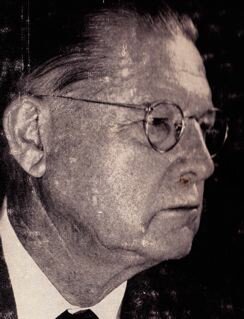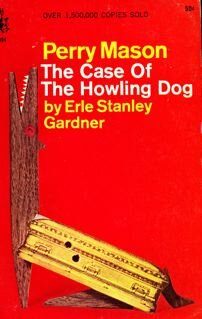You are hereFamous Folks and Me / Erle Stanley Gardner
Erle Stanley Gardner
The Case of THE BANG-UP BIRTHDAY
 By TOM SOTER
By TOM SOTER
Three years after I met Charlie Chaplin, I had a brief correspondence with someone who was much more significant to me at the time: Erle Stanley Gardner.
It was July 1969, and I was 12 years old, going on 13 in just three months. As I entered my teenage years, I continued with my childhood habits: watching my favorite television programs (Daniel Boone, Ironside, Perry Mason, The Prisoner), making radio shows with my friends on reel-to-reel tape-recorders (crazy things with tiltles like Planet of the Nuns and West that Wasn't), going to the movies (James Bond was a favorite along with revivals of classics at Theater 80 St. Marks, the Thalia, and the Regency, all long-gone movie houses), and reading my favorite authors.
Reading was, like everything else I did, done obsessively: I would find an author I liked, and then read everything by him I could find. In 1966, to widen my interests away from Daniel Boone, my dad introduced me to Tarzan, and I was soon going through all 25 Tarzan novels by Edgar Rice Burroughs (titles that I could recite – rather scarily, I think now – to friends and family in chronological order), as well as his 11 Mars books, 7 Pellucidar novels, 4 Carson of Venus books, and so on through ERB's entire oeuvre. Then in 1968, I discovered Erle Stanley Gardner. I don't remember exactly how I hit upon him, except that iit must have had something to do with my watching reruns of Perry Mason on TV (it was on at 11 P.M. weeknights on Ch. 11 in New York, and I would catch it on Friday nights, which was my marathon TV-watching night, starting with Wild Wild West at 7:30 and ending with Mason at 11). Raymond Burr's lawyer-sleuth Perry Mason was a commanding figure: the lawyer who always got his quarry through relentless cross-examination of prosecution witnesses, finally obtaining a murder confession, usually on the basis of circumstantial evidence and frequently in a preliminary hearing (not even a real trial). Perry Mason had been a log-running hit, from 1957-1966, and it was the brainchild of Gardner, who, by 1969, had become the best-selling, arid most prolific American writer of the 20th century, with paperbacks selling at the rate of 20,000 a day and all-time sales, as of 1977, nearing 304 million copies in 23 languages. The lawyer-detective, who ultimately starred in 82 novels, a dozen short stories, six movies, 271 television episodes, and countless radio shows, first appeared in The Case of the Velvet Claws in 1933. It was turned down by a number of publishers before being accepted by Thayer Hobson, president of William Morrow & Co., who suggested that Gardner specialize in a series character rather than create new heroes and new locales for each adventure.
Perry Mason had been a log-running hit, from 1957-1966, and it was the brainchild of Gardner, who, by 1969, had become the best-selling, arid most prolific American writer of the 20th century, with paperbacks selling at the rate of 20,000 a day and all-time sales, as of 1977, nearing 304 million copies in 23 languages. The lawyer-detective, who ultimately starred in 82 novels, a dozen short stories, six movies, 271 television episodes, and countless radio shows, first appeared in The Case of the Velvet Claws in 1933. It was turned down by a number of publishers before being accepted by Thayer Hobson, president of William Morrow & Co., who suggested that Gardner specialize in a series character rather than create new heroes and new locales for each adventure.
I loved the Mason novels almost as much as I loved the Tarzan adventures (although there were three times as many of the former as the latter). I methodically went through the Mason stories (eventually reading 60 or so of he 82 Masons). They were crackling good whodunnits, much more involved than the TV shows but just as tightly plotted. As a stylist, Gardner was no Henry James, but he was a damn fine storyteller, keeping the pace and your interest up to the last page.
In July 1969, I was in"exile" in a house by the beach in Greece from June to September (my parents called it a vacation – one that I would welcome now – but at the time I was frustrated being separated from my friends and habits). While there, I wrote a letter to Erle Stanley Gardner, wishing him a happy birthday (it was on July 17, and he was turning 80). It was probably like no other fan letter or birthday greeting he had ever gotten. I don't remember all of it, but it essentially said, "Dear Mr. Gardner, I wanted to wish you a happy birthday. You are my second favorite author" – Burroughs was my favorite – "and I have read 43 of your Perry Mason novels, which I enjoy immensely."

Soters in Greece, 1969.
My father, in America at work (he would join us periodically in our months-long stay in Greece) sent the letter to Gardner's publisher, and when I returned to New York in September, there was a response waiting for me. It was on stationary that featured a drawing of cactuses in the desert, with letterhead that read, "Erle Stanley Gardner, Rancho Del Paisano, Temecula, California." I remember being very excited as I read,
Dear Tom,
It was very thoughtful of you to send me a birthday greeting – and doubly so for you to take time out while you are vacationing. I had a bang-up birthday and your letter certainly added to my enjoyment... Thanks a lot for remembering me, and I hope you had a wonderful vacation.
It was signed, in an almost unintelligible scrawl, "Erle Stanley Gardner."
That was the extent of my "correspondence" with the great man. Since then, I've met many other heroes of my youth, and although each encounter was exciting in its own right, none hit me in quite the same way as Gardner's letter. Its kindness overwhelms me to this day: rather than ignore a neurotic 12-year-old (after all, who tells a best-selling writer, "you are my second favorite author"?), he not only responds but treats the kid as an adult (very classy for him to thank me for taking time from my vacation to write him, reversing our importance). For a skinny pre-teenager, such respect from an adult was delightful.
Gardner died about six months later. He had millions of fans and presumably millions of mourners, but out of all of those, I remember thinking at the time, no one else had added to his enjoyment the way I had. I figured that, for at least one brief moment, I was special. And yes, Mr. Gardner, I had a wonderful vacation.
May 1, 2010
